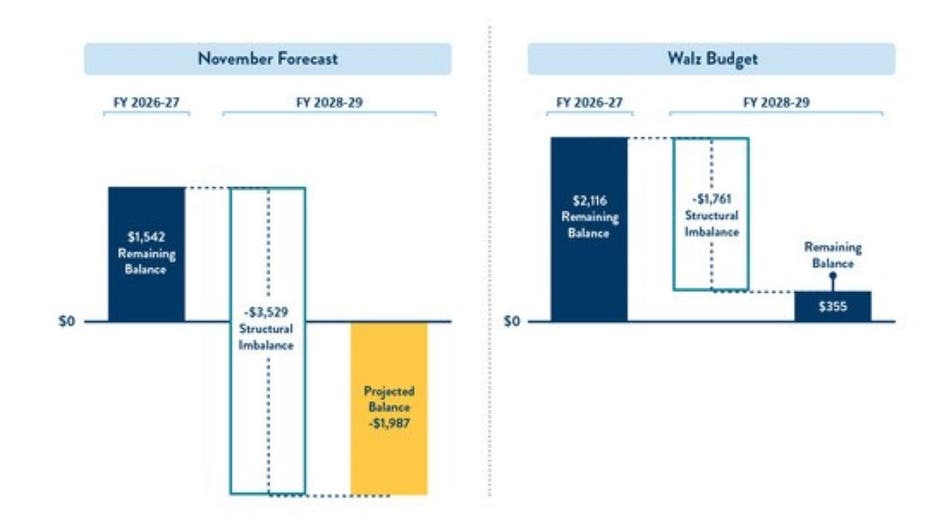Gov. Tim Walz's budget proposal for Minnesota: Here's what's in it
![Gov. Walz budget proposal for Minnesota [RAW]](https://static-media.fox.com/fmcv3/prod/fts/A-806943/uvbv676niov8a8ag.jpg)
Gov. Walz budget proposal for Minnesota [RAW]
Here's Minnesota Gov. Tim Walz's full press conference on his budget proposal.
ST. PAUL, Minn. (FOX 9) - Minnesota Gov. Tim Walz presented his two-year budget proposal on Thursday amid an ongoing power struggle at the Capitol.
Walz's budget proposal
What they're saying:
Gov. Walz on Thursday said he's proposing a "responsible" budget to curb state spending to balance the budget.
The budget proposal includes "the first sales tax cut" in Minnesota history, and closes tax loopholes for services offered by wealth managers and lawyers, a press release says. The proposal also aims to combat fraud and curbs spending growth in programs that drive deficit.

Gov. Tim Walz's 2025 budget proposal.
"This budget is responsible, measured, and honest, and it starts with one goal: fiscal responsibility," said Walz in a statement. "Our plan sets Minnesota up for success in the future by addressing long-term budget challenges and protecting the investments we made to improve lives, including universal meals, paid family and medical leave, and tax cuts for seniors and middle-class families."
Walz says if his budget is passed as proposed, it would leave $2.1 billion on the bottom line in Fiscal Year 26-27, and $355 million in Fiscal Year 28-29.
By the numbers:
Here are some highlights from Walz's budget proposal:
- Walz is proposing cutting the statewide sales tax by 0.075%. If approved, it would be the first sales tax cut in Minnesota history.
- Walz's budget proposes an increase in the surcharge currently levied on health maintenance organizations from 0.6% to 1.25% of total premium revenue, to ensure large health care corporations pay their fair share.
- Walz says the budget will limit year-over-year growth rates in Medicaid waivers without limiting eligibility for services, saving the state more than $1.3 billion.
- Walz says the budget cuts state funding to private schools and includes a 5% reduction in special education transportation reimbursement costs, saving about $50 million in each of the next two-year budget cycles while incentivizing schools to create efficiencies in transportation.
- Walz's budget includes an "anti-fraud package" that increases controls and offers greater oversight by strengthening enforcement authority and creating tougher penalties. It includes added nine staff members to the Attorney General's Medicaid Fraut unit, gives some agencies more authority, and increases the criminal penalty for stealing public funds by 20%.
- Walz's budget expands the Research and Development tax credit.
- Walz's budget expands Minnesota’s Sustainable Aviation Fuel tax credit and supports the growth of the industry.
- Walz's budget contains permitting efficiency measures to shorten the time it takes for businesses to obtain the permits needed to safely operate in Minnesota.
Here's the full budget proposal.
Minnesota budget outlook
The backstory:
Two years after seeing a record-setting projected surplus of $17.5 billion in 2023, the Minnesota Legislature will be faced with much less of a fiscal cushion this session as state leaders projected a $616 million balance at the end of the Fiscal Year (FY) 2026-27 biennium, according to the budget outlook released in December 2024. That's $1.1 billion lower than previously forecast.
The budget outlook is often the playbook for crafting the two-year budget. And with less money to spend this year, it's expected that Walz's plan will likely feature measures to control spending.
This comes after the last budget year in 2023 when Democrats, who controlled the governor's office, House and Senate, passed a roughly $70.6 billion budget plan — the highest ever in the state.
What's next:
Another economic forecast will be released in February, and then state lawmakers in the House and Senate will craft their own budgets.
The budget will need to pass both chambers and receive the governor's signature before July 1 or some parts of the state government could face a shut-down.
Power struggle at the Minnesota Capitol
Dig deeper:
Walz's budget announcement on Thursday comes as a power struggle in the Minnesota House of Representatives continues. Democrats and Republicans continue to argue about a power-sharing agreement in the House, with DFLers sitting out the first day of the legislative session believing they blocked a quorum. However, Republicans carried on as usual with a regular floor session — albeit a half-empty one — and committee hearings.
Democrats have filed a petition to the Supreme Court against Republicans after they carried on business as usual this week, and they've asked the court to decide whether a quorum requires 68 or 67 members of the 134-member body. Only 133 members are currently sworn in, and Republicans have the current majority, 67-66.
READ MORE: Taxpayers footing bill for political battle over Minnesota House
A special election on Jan. 28 in House District 40B will determine if the House is evenly split 67-67 or if Republicans control the House by a margin of 68-66.
Meanwhile, in the Senate, Republicans and Democrats have agreed on a power-sharing agreement for the time being. The chamber is tied at 33-33 due to a vacant seat in Senate District 60. A special election for that seat will be held on Jan. 28.

